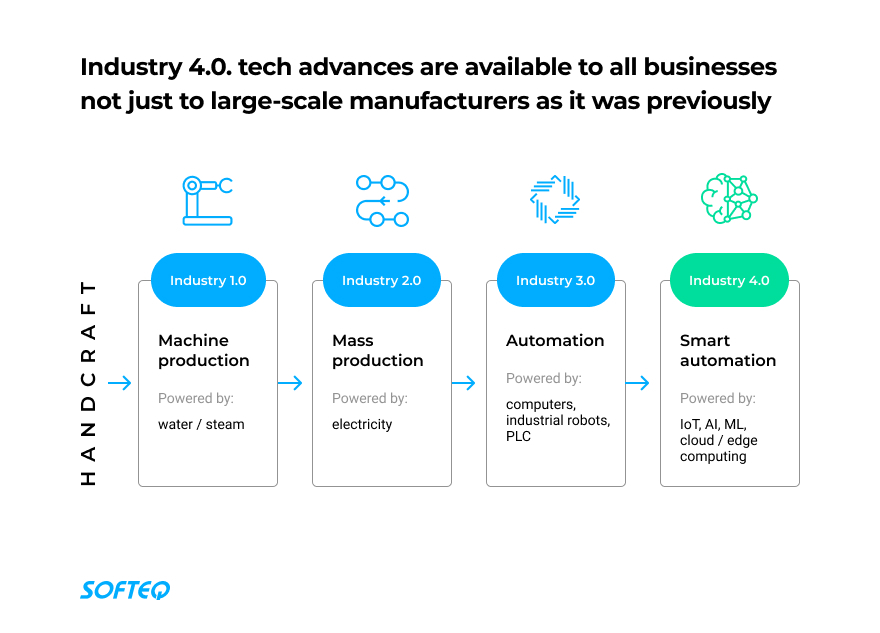Check out our latest blog article: From component to enterprise – modular robotics done right.
How to Create a Successful Strategy of Digital Transformation with IoT and AI

The technologies that drive digital transformation are far from new. IoT began its development back in the 1970s. At that time, sensor data was used to control edge devices. Professors in American universities were already lecturing on machine learning 30 years ago. But it’s only now that their usage is paying off in business—with cloud systems, AI, and smart automation. There are several reasons for that.
First, the technology itself has become more accessible. For example, Amazon has provided businesses with access to AWS cloud services. Microsoft, with its Power Platform, supports civilian programming. Developers with limited expertise in machine learning can now use Cloud AutoML from Google to train high-quality models for their business needs.
Secondly, data storage has become cheaper. Acquiring and processing data is now much easier than ever. This creates the abundance of data needed to improve the accuracy of ML algorithms. What’s more, now you can simply buy data for better training of algorithms.
As a result, technologies and data have become available to businesses.

In this article, we’ll show you four amazing digital transformation examples. We’ll also provide you with some tips on how to create a successful digital transformation strategy for your business.
What Are the 4 Main Areas of Digital Transformation?
Companies that plan to transform their business with digital technology can do it in four main areas:
- Offering a new product. IoT and AI make it possible to create improved products that will better fit changing market demands. They can feature an improved design, high-quality components, more durable materials, user-friendliness, or innovative features. With such a future-proofed approach, companies can secure revenue in a changing business environment.
- Offering a new service. The data provides great opportunities for services that better meet customer’s demands. This is especially relevant for maintenance services. Companies that produce products, such as equipment and machinery, can add sensors to their product. That way, they can monitor equipment conditions in real-time. When something goes wrong, they can quickly determine the cause of the breakdown and fix it, even remotely. By applying AI, they can also predict breakdowns and replace parts before anything happens.
- Improving business processes. By automating common tasks, companies can optimize their internal processes. Among other things, the benefits include lower costs, reduced cycle times, and increased quality. All that can speed up your work and increase customer satisfaction.
- Creating a new business model. Charging for the use of a service rather than selling the product itself has generated a new, as-a-service business model. This allows customers to pay for the use of the product, not the product itself. Thus, the customer doesn't need huge initial investments to start using it. Moreover, they avoid unexpected expenses associated with repairs and maintenance. These benefits attract more customers. A large number of users allows the company to get extensive feedback by collecting data from all interactions around their product. Such feedback helps improve the quality of their product/service and attracts even more customers.
What Are Examples of Digital Transformation?
- Extending Portfolio with a Future-Proofed Product
Shoe machine manufacturer Desma fears that Shoe 3D Printer will take over their niche in the future. This would cause a drop in demand for their traditional machines. To secure their profit, Desma is working together with HP on a new product for their portfolio. Fitstation is a cloud-based solution that captures foot parameters. In the cloud, it analyzes this data and creates the ideal shoe profile. Using a virtual model of their feet, customers could print shoes on a 3D printer. They could also order perfectly fitting shoes from an online store. - Providing a Customer with Additional Services
HELLER is a manufacturer of machines for metal-cutting processes. They developed an IoT solution that captures data on how their machines operate in real time. In a mobile app, they can track all operations and machine statuses. The company uses the solution to do maintenance work for their customers under a service agreement. If unexpected issues occur, HELLER can react immediately to prevent their clients from downtimes. - Accelerating Internal Processes
INnUP is a German printing service provider with 5 employees. Clients come to the company for printing in unusual formats or on special paper. The company's job is to find suitable printeries for such orders. Now this can take up to 24 hours. To speed up this process, the company uses AI. At the moment, the custom algorithm is at the training stage. In the future, it’ll be able to calculate the price and create a quote in a few minutes. - From Traditional Product to Product-as-a-Service
Elitebeds is a traditional mattress manufacturer in Switzerland. Their main customers are hotels. When there was a phase of declining demand for their mattresses, the company came up with a new model, which they called Smart Lease. They suggested that hotels pay for the use of mattresses instead of buying them. For that, Elitebeds equipped the mattresses with motion and pressure sensors, which accurately record the effective occupancy of each bed. After that, the duration of mattress use is visualized on a clear dashboard. With the new business model, Elitebeds could not only secure their sales, but also capture new market shares in the Middle East and South Africa.
How to Create a Successful Digital Transformation Strategy
If you’re considering a digital transformation for your business, you need a well-thought-out strategy. It should contain a vision of what the business is transforming from and into, and why you are transforming.
Otherwise you can repeat Ford's bad experience. In 2015, they created a new business unit called GE Digital to make the most of their data. The problem was they had no incremental strategy. Trying to transform it all at once, they spent $ 900 billions dollars to no avail.
A good digital transformation strategy will make a difference in the mind of a customer. This will help you create a new sustaining competitive advantage and carve out a new niche in the market.
Are you already thinking about transforming your business? The following guidelines can help you prosper in the digital world.
- The customer first, not the technology. Yes, AI and IoT are now more easily available than ever. But don’t forget that technology is just a tool to achieve business goals. First, understand the challenge you’re trying to solve. Then, you can determine how technology can support it. Take the time to listen to customers and fundamentally learn their needs. Only when you know what problem the client struggles to solve, can you choose the technology that's perfect for it.
- Start small, then iterate. Once you’ve identified the customer’s problem and the right tech-stack, don't go rushing in blindly. Instead, it’s better to start small with a proof-of-concept. Try it out, evaluate, make small changes, and then repeat. If everything works well, then you can scale up. This will help you react to changing conditions in a timely manner.
- Empower your employees. Digital transformation requires rapid change. It's okay if your employees may be resistant to changes and skeptical about new things. Try not to look at it as a brake on progress. Instead, include your frontline in decision-making and allow them to provide feedback. This will create a culture of empowerment and trust.
- Plan a sufficient budget. When the vision and the technology are determined and all staff members are on board, you can begin to roughly estimate how much this initiative will cost. Remember, though, that digital transformation isn’t a one-time project. It’s an ongoing approach to how you do business. Keep in mind that this may affect all areas of your business: employees work, communication with clients, and internal processes in the company.
- Set the right success measures. It's important to get to market on time and stay within the budget of the project. But it’s much more important to focus on gradually increasing the ROI for future projects as a result of the digital transformation initiative. Many projects fail because they haven't been given a few more dollars or a couple more sprints to get it right.
Bottom Line
Digital transformation is more than just adding technology. Sometimes it's a fundamental transformation of all business areas of the company. Luckily, you don’t have to manage it alone. Our digital transformation experts will help you ideate your solution, understand emerging technologies, create a detailed roadmap, and deliver your first PoC or MVP solutions.
More articles on the topic






